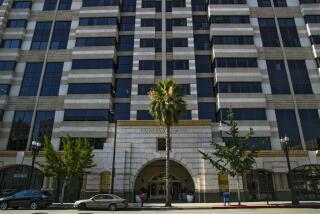North America Savings & Loan Involved in Plethora of Legal Problems
- Share via
Janet F. McKinzie kept a caricature of herself hanging on her office wall at North America Savings & Loan Assn. The caption stated: “Master of Disaster.”
The title is appropriate, according to federal regulators who are trying to unravel what happened at the failed Santa Ana savings institution.
In an amended complaint filed last month in U.S. District Court in Los Angeles, the Federal Savings and Loan Insurance Corp. claims that McKinzie and 54 individuals and companies turned North America Savings into a financial disaster through a complex series of sham transactions.
More Defendants Expected
State regulators allege that it is the worst case of insider fraud ever uncovered at a California savings and loan.
As investigators continue to pore over truckloads of records, FSLIC lawyers said they expect to add more defendants and more claims to the lawsuit.
They allege that McKinzie and the late Duayne D. Christensen, North America’s founder and chairman, set up at least 120 companies for various purposes, and only a handful have been thoroughly investigated so far.
To ensure against loss of potential evidence, Mayer, Brown & Platt, a Los Angeles law firm retained by FSLIC to pursue the lawsuit and find out what happened to the S&L;’s assets, is duplicating and microfilming documents and storing copies elsewhere.
McKinzie has so far refused to comment on FSLIC’s allegations. Her lawyers said they have not read the agency’s 118-page amended complaint because she has not been able to pay them. A court hearing on their request to be relieved from representing McKinzie is scheduled for Oct. 19.
S&L; Declared Insolvent
Her lawyers said, however, that while McKinzie expects to be indicted on criminal charges arising from the ongoing investigation, she has said that she is innocent of wrongdoing.
State regulators seized North America Savings on Jan. 16, only hours after Christensen was killed when his brown 1985 Jaguar crashed into a bridge support on the Corona del Mar Freeway.
A week later, the state determined that North America Savings was insolvent and called in federal regulators, who closed the institution and transferred its assets to a newly chartered federal S&L; of the same name.
FSLIC was appointed receiver and began sifting through thousands of documents. Investigators found scores of seemingly bogus deposit accounts, allegedly forged signatures, false statements and evidence of conflicts of interest and an elaborate cover-up, according to the lawsuit and previously filed court documents.
The suit alleges that the conspiracy occurred in order to artificially inflate the net worth of North America Savings and to create the illusion of profitability.
The mastermind behind the systematic “looting” of the S&L;, the suit claims, was Christensen, a Westminster dentist who gave up his dental practice to engage in other businesses.
Christensen formed North America Savings in September, 1983, and the FSLIC suit claims that he and McKinzie then used federally insured deposits for their personal benefit.
McKinzie was Christensen’s confidante, business manager, sole heir and only beneficiary of his $10-million life insurance policy, the proceeds of which are being held in escrow until the court resolves competing claims by the S&L;, Christensen’s three children and others.
Hired as Consultant
McKinzie, who began working with Christensen in 1980, also was his fiance, said Kent P. Larsen, an independent insurance agent who put together the $10-million life insurance policy.
And McKinzie was “de facto vice chairman” of North America Savings, even though she was hired only as a consultant, FSLIC claims in its suit.
The network of family members and professional associates assembled by Christensen to help carry out his investment schemes dates back at least as far as Aug. 29, 1971, when Christensen formed Newport Equities Trust, the suit contends.
Newport Equities was a business trust and the primary vehicle for Christensen’s investments. Christensen owned 27% of the trust and persuaded a number of doctors and dentists to invest with him.
“North America Savings appears to have been operated as a shadow entity of Newport Equities,” Erickson said. A number of major Newport Equities properties were sold to the S&L;, the suit claims. The trust eventually was liquidated in 1984, the suit states.
One scheme detailed in the suit--the Summerton project--is typical of the way in which Christensen, McKinzie and their associates allegedly siphoned money from North America Savings, Mayer, Brown attorneys said.
The project involved the purchase and purported development of condominiums on 13 acres near San Jose.
The suit claims that more than $6.4 million in S&L; deposits were funneled into the hands of Christensen, McKinzie or their associates through a repurchase scheme and through kickbacks from Summerton vendors and subcontractors who provided no services or materials.
Newport Equities sold the land to North America Savings on Dec. 21, 1983, for $7.7 million. Over the next two months, the S&L; sold 10% of the project to three investors, including S&L; director Myron S. Mickelson, a Huntington Beach physician, for nearly $4.8 million, according to the lawsuit.
Net Worth Inflated
When the S&L;’s executive committee, headed by Christensen, decided in May, 1984, that the new arrangement would delay construction, the committee decided to repurchase the 10% interest for $5.6 million--$800,000 more--even though no improvements had been made, the suit contends.
The S&L; had recorded the $4.8-million sale as income, and it failed to remove the sum from its books until ordered by regulators to do so in December, 1984, thus artificially inflating the S&L;’s net worth for most of the year, the suit states.
Meantime, North America Savings authorized McKinzie in September, 1984, to handle all Summerton construction matters, the suit states. Central State Construction, one of the firms owned by McKinzie, became the project’s general contractor.
The suit alleges that Central State, Christensen and McKinzie conspired with about 20 other defendants to divert more than $5.6 million from the S&L; through the Summerton project during 1985 and 1986.
The S&L; paid some of the money directly to Central State and three other McKinzie-owned firms, Norcal Marketing & Public Relations, Interstate Management and Elk Grove-based Plaza Group, her real estate company, the suit claims.
In addition to the Summerton project, the FSLIC suit details alleged frauds involving other real estate ventures. Among the allegations are claims that:
- Christensen and McKinzie created a paper trail showing that they were using Plaza Group and two other companies to withdraw $11 million from North America Savings to bankroll real estate purchases. But, the suit contends, no real estate purchases were made, and, the money was split up among Plaza Group, its parent company, an Arkansas firm with ties to McKinzie and Christensen’s uncle, George R. Wheeler. The agency alleges that $165,000 of the $6.9 million that went to Plaza Group and its parent company was used to buy McKinzie’s Rolls Royce Corniche, which bore a license plate that read XTACI.
- Christensen, McKinzie, Victoria Walker and two S&L; employees conspired to cover up the $11-million real estate fraud by making false statements about what had happened to the money and who controlled it, creating fake North America Savings records showing that the funds were in deposit accounts at Imperial Bank and Bank of Alex Brown and forging signatures on bogus letters and phony certificates of deposit to confirm the deposits. An exhibit attached to the lawsuit shows McKinzie admonishing Walker to “be sure to sign good” the phony letters and to put them “in sealed envelopes so it looks professional.”
- Christensen, McKinzie and others caused North America Savings in November, 1983, only two months after the S&L; opened, to buy property in Victorville from Sunnyslope Corp., which was controlled by Christensen and McKinzie, for more than $1.8 million--nearly twice the $960,000 Sunnyslope paid for the property two months earlier.
- North America Savings paid McKinzie and Plaza Group excessive fees and commissions and unwarranted expenses totaling nearly $3.5 million for consulting work in 1985 and 1986. More than $934,000 was used to pay off McKinzie’s credit card, Neiman Marcus, jewelry, decorator and Learjet charter bills, the suit contends.
The suit alleges a number of cover-ups, including an elaborate charade in which McKinzie sent written “scripts” to her former husband, Kenneth McKinzie, to S&L; director Merrill Schmidt and to a Newport Beach real estate broker.
The scripts, attached as exhibits to the suit, told the men what to say if regulators or private investigators questioned them about Christensen’s interest in Newport Equities Trust or the trust’s sale of a 20-unit South Lake Tahoe condominium building to the S&L.;
Stories Scripted
“You and I have got to get together prior to your answering any questions regarding the matters you discussed with Doc,” her Aug. 29, 1986, letter to the Newport Beach broker states. “Your story should go something like this:”
The letter then lists nine items the broker should include in his story.
The South Lake Tahoe condominium, Kingsbury of Tahoe, had been a thorn in the side of state regulators almost since North America Savings opened its doors because Christensen had contributed the equity in the building to the S&L;’s capital base and was trying to inflate its value, state regulators have said in court papers.
The FSLIC suit claims that a Newport Equities subsidiary called Tahoe Bronze bought Kingsbury for $3.7 million in December, 1982, and sold it a year later to the S&L; for $14.7 million. The suit alleges that the condominium project was worth only $2.4 million.
In addition, Christensen and McKinzie diverted about $5.6 million in S&L; funds for the purpose of paying off an existing mortgage on the property, the suit alleges, but the mortgage holder never received the money.
More to Read
Inside the business of entertainment
The Wide Shot brings you news, analysis and insights on everything from streaming wars to production — and what it all means for the future.
You may occasionally receive promotional content from the Los Angeles Times.










